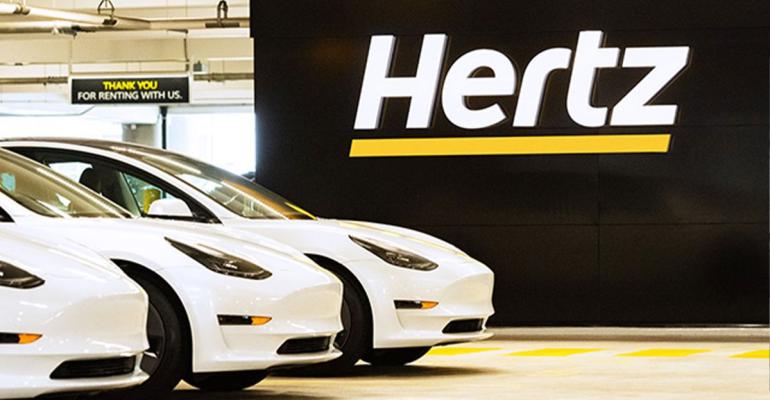The future of the battery-electric-vehicle rental market in the U.S. is highly uncertain amid falling BEV resale values and persisting maintenance challenges.
While the American car rental industry has collectively purchased more than 100,000 BEV and other zero-emission vehicles (not including hybrids) to date, consumer demand for such cars is still evolving, according to the American Car Rental Assn. (ACRA).
“Both consumers and rental companies are facing the same challenges that the entire EV ecosystem is wrestling with – range anxiety, access to chargers and a lack of familiarity with EVs in general,” Gregory Scott, a spokesperson for ACRA, tells WardsAuto.
Sixt USA, a subsidiary of Germany-headquartered Sixt SE, and American rental car giant Hertz Global Holdings are slashing their BEV fleets after experiencing expensive repair costs, weak customer demand and a dramatic drop in resale prices for such cars.
“The environment for the resale of used BEVs has worsened over the past year. In the U.S., for example, the resale value of top-selling electric vehicles fell almost a third in 2023,” a Sixt spokesperson says.
“Sixt has also experienced the effects of this development and reacted quickly to it: reducing the number of electric risk vehicles in our fleet in response to the increase in depreciation – that is, vehicles for which there are no buyback or leasing agreements, and for which Sixt therefore bears the residual value risk itself,” the spokesperson says.
A March iSeeCars study found that used BEV prices have fallen 31.8% over the past 12 months, largely driven by the aggressive price cuts on new Teslas.
The falling residual values for BEVs depressed Sixt’s earnings by about $43.6 million during 2023, the company reports. Hertz, on the other hand, expects about $245 million in costs related to depreciation expenses from BEV sales in fourth-quarter 2023.
Scott says the largest challenges for U.S. car rental firms involve BEV infrastructure. With the public charging network still a work in progress, the main concerns for consumers considering a BEV rental are vehicle range and where and how to charge the vehicle.
Melanie Methven, secretariat official and consultant of U.K. and Europe-focused ACRISS, formerly the Association of Car Rental Industry System Standards, tells WardsAuto that range anxiety is particularly intense among new BEV drivers: “Customers who don’t own (BEVs) have increased anxiety on many factors such as charging points, charging payments, charging equipment and low battery ranges.”
Scott anticipates that increasing the availability of chargers across the country will help address these concerns. He notes the bulk of BEV charging in the U.S. takes place at home, whereas BEV rental customers are primarily reliant on the public charging infrastructure.
In America, Hertz has been expanding its BEV charging network through a partnership with BP Pulse and has installed ultra-fast chargers in New York City, Denver and Houston.
Meanwhile, U.S. car rental agency the Avis Budget Group has prioritized the development of its BEV charging infrastructure over the purchase of BEVs. The group launched its first large-scale BEV charging solution in 2023 at the George Bush International Airport in Houston.
“Our strategy was to first develop the infrastructure to properly charge vehicles of this type in a way that allows for a seamless rental and efficient use of this asset,” Joe Ferraro, Avis Budget CEO and president, said in February
BEV damage and repair costs are also causing a headache for the industry. Research by U.S. vehicle lifecycle management company Solera Holdings concluded that globally, BEV repair costs were 29% higher than ICE repair costs and BEV parts costs were 48% higher.
High damage and collision costs are one of the reasons Hertz is selling off 20,000 BEVs, including Teslas, from its U.S. fleet (11). This represents roughly one-third of its global EV fleet. Additionally, the company is pausing plans to buy 65,000 BEVs from Swedish electric car maker Polestar over five years.
“We pinched off the single largest component of that cost challenge, which is the EVs,” Stephen Scherr, Hertz’s former chair and CEO, said in February. To replace the BEVs, Hertz is redeploying 15,000 lower-cost ICE cars around its network.
Meanwhile, Avis Budget has insulated itself from maintenance-related concerns, recalls and any residual value pressures by ensuring it purchased BEVs from a varied group of manufacturers.
“We have vehicle makes and models of all types and especially around hybrid PHEV (plug-in hybrid BEVs). We’ve gotten those in late during this past year,” says Ferraro, adding that customer acceptance of them was strong.
For now, new BEV purchases by Hertz are going to be limited to those packaged with other ICE vehicles, according to Scherr. Sixt appears to be pursuing a similar strategy, with its latest BEV purchases part of a larger order of up to 250,000 vehicles from Netherlands-based global automaker Stellantis, representing a wide range of propulsion types. The vehicles will be added to Sixt’s rental fleet across Europe and North America by 2026.
That said, in the future, U.S. car rental firms may have little choice but to purchase more BEVs due to the EPA’s upcoming car emissions standards that will apply to model years 2027 through 2032.
The EPA on March 20 announced revised standards stating the industry could meet emissions limits if 56% of new-vehicle sales were electric by 2032, along with at least 13% PHEVs or other partially electrified cars, as well as more efficient gasoline-powered cars that get more miles to the gallon.





